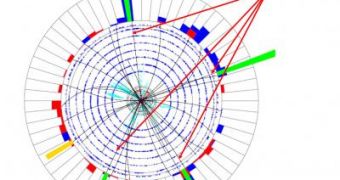Researchers of the Fermilab announced recently that they have been able to produce and observe one of the rarest diboson processes, the ZZ pair, during proton-antiproton collisions inside the world's most powerful particle accelerator, the Tevatron. The discovery bears significant scientific relevance, since the Higgs boson is the only predicted particle believed to have rarer diboson processes than that of the ZZ pair.
Z particles are vectorial bosons responsible for mediating the weak electromagnetic force between other elementary particles along with the W boson. Unlike photons which have zero mass, the Z and W bosons have masses comparable to that of the whole iron atom, which reduces significantly the range of weak nuclear forces. ZZ pairs rarely occur in production processes, property reflected by the fact that they haven't been discovered until now.
But their detection now suggests that similar dibosons involving Higgs bosons may be discovered, proving that the so-called 'God Particle' exists. ZZ pairs can also have signatures close to that of high mass Higgs bosons, although in the case of low mass Higgs bosons, the two particles could create ZH pairs, which also have similar characteristics to those of ZZ dibosons.
The experiments began at the Tevatron particle accelerator with the creation of W and photon pairs, and moved progressively to Z and photon pairs, WW and WZ dibosons. In April, the experiment was able to reveal the presence of ZZ pairs, the most massive of the possible combinations of known bosons - except for those involving the Higgs boson, which hasn't been discovered yet - thus having the lowest possible production probability.
"Final analysis of the data for this discovery was done by a thoroughly international team of researchers including scientists of American, Belgian, British, Georgian, Italian and Russian nationalities. They worked closely and productively together to achieve this challenging and exciting experimental result," said Darien Wood, spokesperson for the Dzero experiment.
After nearly 200 trillion proton-antiproton collisions, the Tevatron revealed the presence of secondary particles originating from the decay of the ZZ pair. ZZ dibosons decay into either electrons, muons or neutrinos. The preferred decay mode of ZZ pairs is through neutrinos, but since they're weakly interacting particles neutrinos are much harder to detect. Alternatively, the dibosons could split into electrons and muons but this decay mode is much rarer and although only three such events were observed, there is clear evidence that ZZ pairs were produced.

 14 DAY TRIAL //
14 DAY TRIAL //